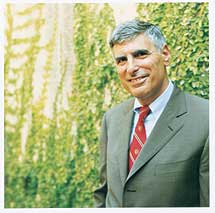 |
|
Dean Philip A. Pizzo, M.D. ; Photograph Leslie Williamson |
|
Dear Readers,
Among the highest priorities in the Stanford School of Medicine Strategic
Plan, “Translating Discoveries,” is the renewal of our programs
for medical student education. That is not to say that Stanford’s
medical school education program is broken but only that it must change
to optimize our resources, given our goal of enabling our graduates to
become the leaders that we believe they must become.
We are blessed with outstanding students at Stanford. Indeed, more than
80 of the students who have been offered admission for the class entering
in September 2003 recently visited the campus, meeting with students
and faculty. Most of them will join the outstanding student body that
has been assembled at Stanford in past years. For example, our current
first-year medical students, who matriculated in September 2002, included
86 students selected from 5,239 applicants.
Our current first-year class is an impressive, diverse group. The average
age is 22.9 years with a range of 19-31 years. A slight majority (53
percent) are women and 21 percent are underrepresented minority students.
Fifteen percent have advanced degrees (six doctorates, 11 master’s
degrees). These students performed very well as undergraduates, with
an overall GPA of 3.74. Seventy-one of the current first-year students
come to Stanford from throughout the United States and 19 were born in
foreign countries. They also come from 38 colleges and universities,
with the largest number coming from Stanford (17 students) and Harvard
(nine students) but with 25 schools being represented by single students.
Seven members of the class were deferrals from previous years and nine
of those admitted have deferred enrollment to fall 2003 or later, permitting
them to engage in activities that will enhance their education and contributions
to the class.
Entrusted with such talented students, we must prepare them for the
important roles and opportunities that await them. Stanford’s record
of creativity in medical student education began with the “Five
Year Plan” when the school first moved from San Francisco to Palo
Alto in 1959. The advantage of having a medical school education in an
environment that brings together on a single campus faculty from schools
of medicine, engineering, humanities and sciences, earth sciences, business,
education and law is nonpareil. Taking advantage of this diverse and
outstanding educational environment has long been one of Stanford’s
greatest strengths. Coupled with this is the opportunity for our students
to learn in an environment that fosters collegiality and permits significant
flexibility. Another distinguishing feature is that in comparison with
medical students throughout the nation, ours graduate with relatively
little debt: a result of the scholarship and grant support the students
receive.
While medical school education must be built on a strong foundation in basic
science, we are reassessing the teaching approach that has long characterized
the medical curriculum across the nation. This past approach compartmentalizes
learning, beginning with the basic science pre-clinical courses that lead up
to the clinical education. Indeed, a fusion of basic and clinical science is
essential if we are to optimize the impact of modern science on the practice
of medicine.
Accordingly, under the leadership of Senior Associate Dean for Medical
Education Dr. Julie Parsonnet, we are engaged in major curriculum redevelopment
for medical students with the goal of instituting the new Stanford curriculum
for the class entering in 2003. One of the overarching goals includes
fostering parallel learning throughout the medical school in both basic
science and clinical medicine to achieve continued connectivity with
the scientific principles that are the foundations of modern clinical
medicine and clinical practice. In addition, we want our students to
pursue independent scholarship through “scholarly concentrations” (or
medical majors) that will enable them to develop specific skills through
a mentored curriculum with associated research. These scholarly concentrations
will be mentored, course-driven and engage students in original or investigative
research in disciplines ranging from molecular medicine to public service.
To accomplish our educational goals, it is also important to critically
assess the extent of fundamental knowledge that students must gather
early in medical school to prepare them for lifetime learning rather
than concentrated rote learning. These changes are, of course, interrelated
and must be further guided by assuring that our students still have an
environment that fosters flexibility and individual development. Such
changes quite naturally foster both excitement and concern.
I am cognizant that change is difficult and that there are many stakeholders,
each with an important perspective. Thankfully, during the past year
our students, faculty and governing bodies including course directors,
the faculty senate and the dean’s office, have aligned to make the
new Stanford curriculum a reality. By doing so, our Stanford community
has united to create a new pathway for the generations to come. I am
confident that the guiding principles shaping these changes will enrich
the opportunities for our students and make education at Stanford transformational
in American medicine for the 21st century.
Sincerely,
Philip A. Pizzo, MD
Carl and Elizabeth Naumann Professor of
Pediatrics and of Microbiology and Immunology
Dean, Stanford University School of Medicine

